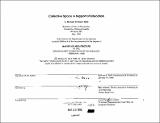Collective space in support of education
Author(s)
Reid, Michael Erickson
DownloadFull printable version (18.80Mb)
Other Contributors
Massachusetts Institute of Technology. Dept. of Architecture.
Advisor
Shun Kanda.The final goal for this thesis is to make an architectural proposal that creates a genius loci for this area and a genius loci with in the school, both of which would reinforce educational potential.
Terms of use
Metadata
Show full item recordAbstract
Over the last two hundred years formal education has developed into a major component of modern society. It is seen as the training of individuals to be free-thinking, contributing citizens. Education has also been touted as the best way to solve many social ills. It is related to improving health, employment opportunities, racial tolerance, and general improvements in the quality of life. Despite our hopes for formal education many of our schools are not meeting even our minimal expectations. The fundamental question this thesis seeks to answer is: How can the architectural experience of a school reinforce the educational experience of the students as well as the school's value in society? Before we can answer this question we have to ask: What is a good educational experience? While there are a wide variety of opinions in relation to this question, I propose that a good educational experience is one that is based on the natural educative experience of living life in a society. This I would cal I 'informal' education and involves five basic principles: observation, imitation, instruction, experimentation, and discussion. These five basic principles are best supported in a community. If this is the natural way that one learns in a non institutionalized setting, and if schools are an institutionalized abstraction of the larger society, then it follows that these activities should take place in the school setting so that education is effective in producing active creative citizens. Based on the premises stated above th is thesis seeks to test the following hypotheses: 1) A cohesive community needs to have a genius loci or "spirit of place" to operate. A necessary condition for a genius loci is a collective space. If a school is meant to be a microcosm of this larger society then it needs to operate as its own community. Therefore it needs a genius loci and a collective place for this genius loci to exist. A successful school should thus have the built opportunity for collective gathering. 2) The school cannot be isolated it must have built exchanges with the larger community so that the school's community is sustained. 3) If the school is the institutionalization of 'informal' education then the school must have a variety of spaces that will allow the five basic activities of 'informal' education to take place at a variety of size gatherings as they do in the larger community. 4) The school's form should be non hierarchical but reflect democracy. To test these hypotheses I have designed a small public high school in Cambridge, MA that not only functions as a high school but also provides a genius loci for the community through the built integrating of school and community functions. The site is situated next to Sonnet Park, which is heavily used by the surrounding, ethnically, racially, and economically diverse neighborhood.
Description
Thesis (M. Arch.)--Massachusetts Institute of Technology, Dept. of Architecture, 1996. Includes bibliographical references (p. 87-89).
Date issued
1996Department
Massachusetts Institute of Technology. Department of ArchitecturePublisher
Massachusetts Institute of Technology
Keywords
Architecture.